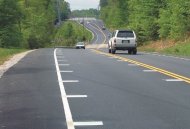7/17/2007
Study Finds Alternatives to Speed Bumps and CamerasA Virginia Department of Transportation sponsored report finds positive alternatives to speed bumps and photo enforcement.

A report released last month by the Virginia Transportation Research Council, a joint project of the University of Virginia and the state department of transportation, finds that there are less invasive alternatives to speed cameras and speed bumps. The study focused on two innovations, LED stop signs and optical speed bars both of which were found to have "traffic calming" effects without any downside beyond the cost of implementation.
The study evaluated a type of stop sign that used eight bright LED lights placed at each of the sign's corners designed to increase its visibility, especially at night. Researchers attempted to collect data before and after the signs were installed to evaluate whether the $1600 solar-powered devices were effective in encouraging people to stop, but different observers failed to agree on what constituted a safe stop. The study then could only focus on observed reductions in speed leading up to the sign.
"Although statistically significant decreases in speed occurred after installation of the flashing LED stop sign, it is questionable whether the very small decreases in actual speeds are practically significant," the report concluded.
Researchers also looked at two types of optical speed bars. One used short lines painted on the sides of the road designed to create an optical illusion of speed. As a driver approached the lines, the space between them decreased. Designers believe that this makes drivers feel like they are accelerating. Another type used thick, wide lines placed across the middle of the roadway that create a slight rumble effect as cars pass over them.
Line painting took about half a day of work and cost about $1800 in time and materials. The study found the lines produced a decrease in speed of between 4 and 12 percent (2-5 MPH) on roads with a speed limit underposted by at least 5 MPH.
"A flashing LED stop sign is one of many tools in a traffic engineer's toolbox that may be applicable at a site given its specific conditions," the report concluded. "Regional traffic engineers should consider the use of optical speed bars as a safety countermeasure to be placed just in advance of a hazardous area, a reduced speed zone, or another roadway/travel change area where the number of crashes is higher than expected or where excessive speeding occurs."
A full copy of the report is available in a 3.6mb PDF file at the source link below.


